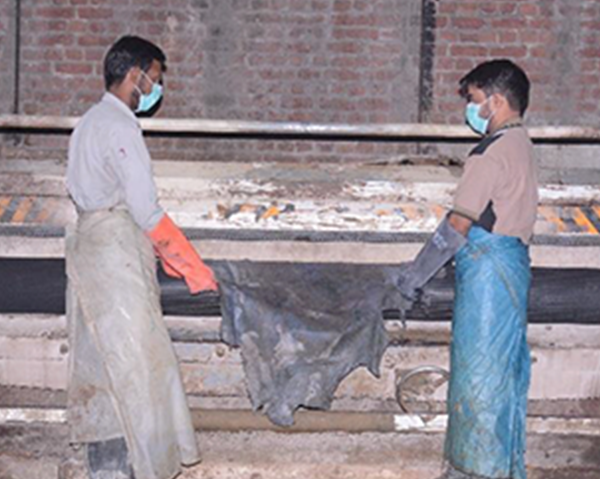Fleshing is one of the vital and indispensable stages in the preparation of hides for tanning in Iran’s leather industry. This step is aimed at thoroughly cleaning the flesh side of the hide from excess tissues, subcutaneous fats, and connective fibers, thereby creating a smooth, clean, and uniform surface that allows effective penetration of chemicals during subsequent stages. The quality of the fleshing process has a direct impact on the durability, softness, dye absorption, and overall appearance of Iranian leather.
After soaking and complete rehydration of the hides, they enter the fleshing stage. In Iran, this process is carried out using specialized mechanized equipment equipped with rotary blades and precision rollers. These machines carefully remove layers of fat, connective tissue, and any residual flesh without damaging the primary fibers of the hide. If such residues remain, they can hinder the uniform absorption of chemicals and may even lead to staining, unpleasant odors, and reduced longevity of the leather.
An important advantage of fleshing in Iran lies in the expertise and craftsmanship of experienced tanners who, in addition to relying on technology, possess a precise understanding of the characteristics of domestic hides. Iranian cow and calf hides, particularly those sourced from the western and northwestern regions of the country, due to their high density and strength, require deeper and more time-intensive fleshing. In contrast, Iranian goat and sheep hides—many of which come from nomadic and rural regions—have finer and more delicate fibers. Therefore, their fleshing process is conducted with gentler settings and controlled speeds to avoid damaging the natural grain of the hide.
Beyond preparing the hide for subsequent steps such as splitting, liming, and tanning, fleshing also plays a critical role in the hygiene and preservation of hides. The complete removal of organic residues minimizes the risk of bacterial growth and gradual spoilage, thereby enhancing the durability and final quality of the product. Furthermore, by creating a uniform surface, it facilitates easier thickness control in later stages, ensuring that the final leather product meets higher standards in both aesthetics and performance.
Key characteristics of the fleshing process in Iran’s leather industry:
- Precise mechanical removal of fats, connective tissues, and residual flesh
- Use of advanced mechanized equipment alongside the craftsmanship of Iranian tanners
- Adjustment of fleshing depth and speed according to the type and origin of the hide
- Ideal preparation for subsequent stages such as liming, splitting, and tanning
- Reduction of spoilage and bacterial growth through complete removal of organic tissues
- Maximum preservation of natural grain and fiber strength for premium quality Iranian leather


No comments yet.